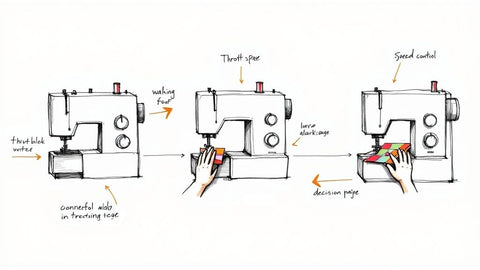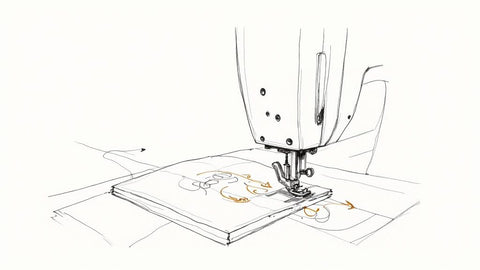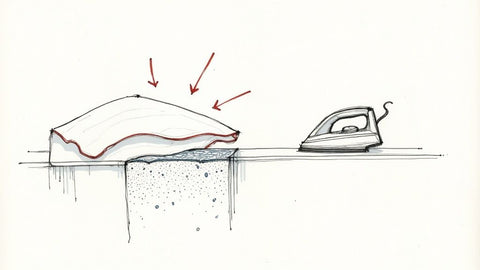When you're trying to find the best sewing machine for beginning quilters, it really comes down to a balance. You need a machine that's friendly enough not to scare you off but tough enough to handle the thick layers of a quilt sandwich. A couple of things are non-negotiable: a decent amount of throat space and rock-solid, consistent stitch quality. These are the features that will make or break your first quilting project.
Your First Step Into Quilting
Diving into quilting for the first time is a huge thrill. It can also feel like a huge decision when you start looking at machines. My advice? Keep it simple. Focus on the handful of features that will make your life easier.
The goal is to find a machine that helps you learn, not one that gets in your way with a million complicated settings you won't use. Think reliability over bells and whistles.
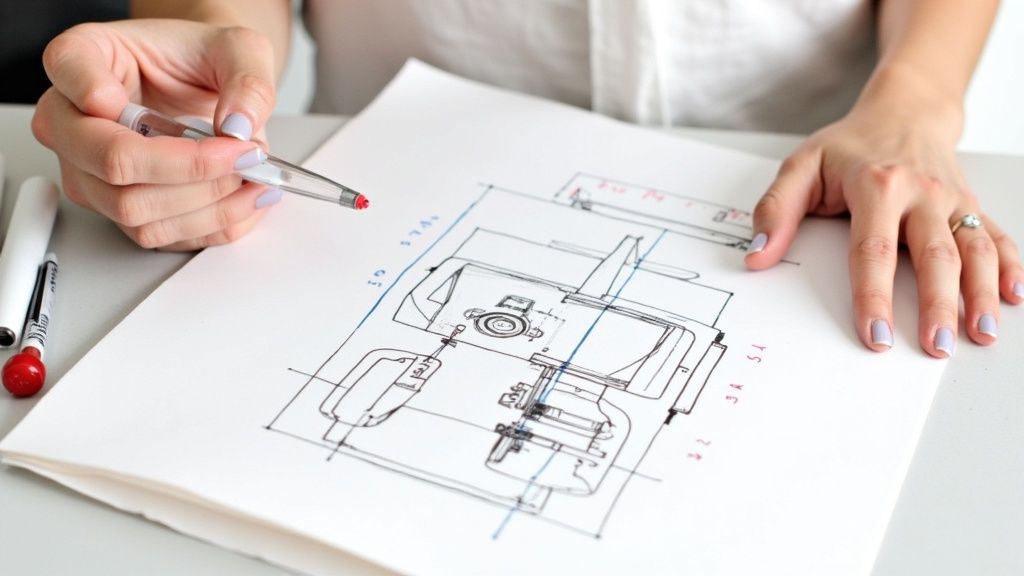
Here at bsewinn.com, we live and breathe that balance. Our commitment is to empower crafters through our custom sewing machine designs. We want to make sure that even a total beginner can sit down and create something beautiful, because we truly believe the right machine and a little bit of support are all you need to get started.
We're Here to Help You Create
You’re not alone on this journey! The quilting world is huge and growing every day. The global market was valued at around USD 5.8 billion and is expected to almost double by 2033. With somewhere between 9 to 11 million quilters out there, you're joining a massive, passionate community. You can see more details on the quilting market here.
This boom means there are more tutorials, patterns, and guides available than ever. We’re all about giving you the tools and the knowledge to feel confident. Our support system is designed to help you replicate tangible designs, empowering you every step of the way:
- Online Classes: Easy-to-follow video tutorials that walk you through how to create specific quilt blocks and projects.
- Comprehensive Training: We’ll show you how to use every feature on your custom-designed machine so you can bring your creative visions to life.
- Extensive Resources: A whole library of articles and patterns to spark your next idea and guide you through the process.
When you pair a high-quality, custom-designed machine with education you can actually understand, a hobby that seems complicated becomes a craft you can be proud of from the very first stitch.
Before you jump in, it helps to know the basics. We put together a guide on the 4 easy steps to start quilting that will give you a solid foundation. Once you have that confidence, you’ll be ready to tackle anything.
Essential Features for a Beginner Quilting Machine
Jumping into the world of quilting is exciting, but picking your first machine can feel a little daunting. The truth is, not all sewing machines are cut out for quilting. Focusing on a handful of key features will make all the difference, ensuring you get a machine that grows with you instead of holding you back.
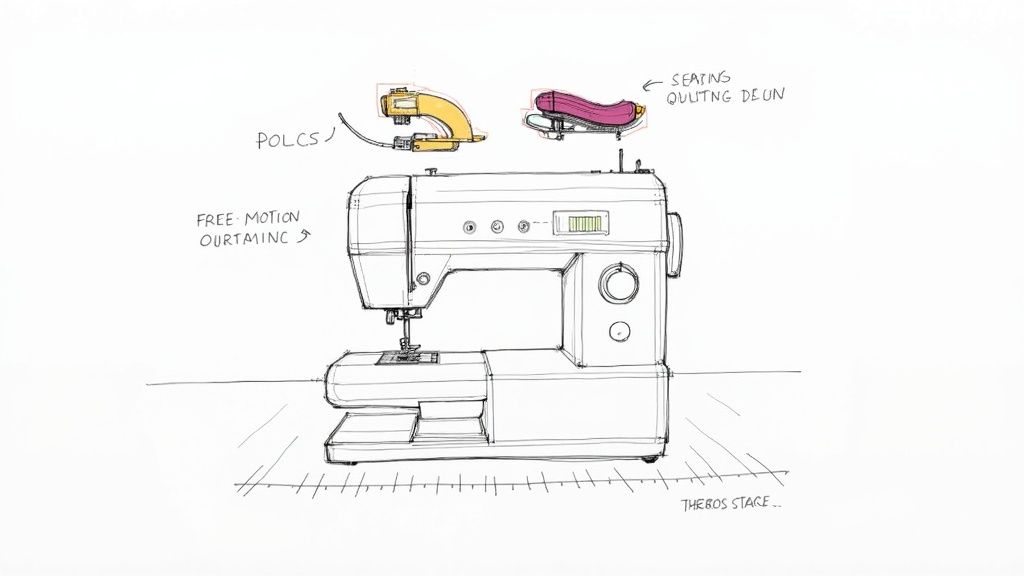
Think of a quilt as a "sandwich"—it has a top layer, a fluffy batting middle, and a backing. Your machine needs to sew through all three layers smoothly without causing any puckers or shifting. This is where a walking foot (sometimes called an even-feed foot) becomes your best friend. It has its own set of feed dogs that work with the ones in your machine, gripping the top and bottom fabric layers and pulling them through at the exact same time. It’s the secret to perfectly flat, beautiful stitches.
You'll also want to look for a free-motion quilting foot. This little accessory, often called a darning foot, lets you drop the feed dogs and move the fabric freely in any direction. It’s how quilters "draw" with thread, creating those gorgeous, flowing patterns that make a quilt truly unique.
Throat Space and Stitch Options
One of the most obvious differences between a standard sewing machine and a great quilting machine is the throat space. This is simply the open area to the right of your needle. A larger throat space—I'd recommend 6 inches or more for a beginner—gives you room to roll up and maneuver your quilt. Without it, you’ll find yourself wrestling and stuffing your project through a tiny opening, which is nobody's idea of fun.
Now, it's easy to get wowed by machines that boast hundreds of decorative stitches, but you really don't need them to start. A beginner quilter just needs a few core stitches that work flawlessly.
- A reliable straight stitch: This is your workhorse. You'll use it for almost all of your quilt piecing, and you need it to be consistent.
- A simple zig-zag stitch: Great for finishing raw edges or trying your hand at appliqué.
- A blind hem stitch: This comes in handy for binding and other finishing touches.
Honestly, a machine that does these three stitches perfectly is far more valuable than one with a hundred fancy stitches you'll rarely touch.
A machine that masters the basics is an artist's best tool. Consistent, high-quality stitches are the bedrock of a beautiful quilt, providing the structure and durability needed for your project to last for years.
Understanding Your Machine’s Controls
Finally, pay attention to the little things that make sewing easier. Features like an automatic needle threader and a needle up/down function might seem like small perks, but they are total game-changers for beginners. The needle up/down button lets you stop with the needle buried in the fabric—an absolute must-have for pivoting at sharp corners without losing your stitch placement. These conveniences make the learning process so much smoother.
To help you keep track of these must-have features, here’s a quick-reference table.
Key Features for Beginning Quilters at a Glance
| Feature | Why It Matters for Beginners | What to Look For |
|---|---|---|
| Walking Foot | Prevents layers from shifting and puckering, ensuring flat, even stitches on your quilt sandwich. | Often included as an accessory, but make sure one is available for your machine model. |
| Free-Motion Foot | Unlocks your creativity by allowing you to "draw" custom quilting designs with thread. | Look for a "darning" or "free-motion" foot compatible with the machine. |
| Throat Space | Gives you room to maneuver bulky quilts without bunching up the fabric. | A minimum of 6 inches is ideal for tackling small to medium-sized quilts comfortably. |
| Needle Up/Down | Allows you to stop with the needle in the fabric for perfect pivots at corners. | A dedicated button on the machine's control panel. |
| Core Stitches | You need a perfect straight stitch for piecing and a few utility stitches for finishing. | Machine should offer a high-quality, adjustable straight stitch and a basic zig-zag. |
| Automatic Needle Threader | Saves time and prevents eye strain, getting you sewing faster. | A built-in lever or mechanism near the needle that pulls the thread through for you. |
Having the right tool from the start makes all the difference. We design our bsewinn.com machines with these essentials in mind, empowering you to build your skills with confidence. And if you're looking for more great tools to round out your kit, check out our guide to the top sewing tools for beginners. With the right gear and a little practice, you'll be on your way to quilting success.
Comparing the Top Machines for New Quilters
Alright, let's get past the feature lists and talk about how these machines actually feel when you’re quilting. When you’re starting out, you’ll mainly run into two types of machines: mechanical and computerized. Each one offers a totally different experience, and what's right for you really depends on your style.
A solid mechanical machine is beloved for its simplicity. You've got knobs and dials—that's it. It can feel way less overwhelming when you’re just trying to get the hang of things. This straightforward design is perfect for mastering a dead-straight stitch line and piecing your quilt blocks together with precision. You turn a dial, the machine responds. It’s a very direct, hands-on way to learn the fundamentals.
On the flip side, a computerized model comes loaded with features that can seriously flatten the learning curve, especially for more creative stuff. If you're itching to try free-motion quilting, having a speed control slider is a game-changer. It lets you slow things way down to build that muscle memory without worrying about a heavy foot on the pedal, which means smoother, more confident stitching from the get-go.
Mechanical Simplicity Versus Computerized Control
The DIY and craft boom has been great for the sewing world. The global sewing machine market, currently valued at USD 4.56 billion, is expected to climb to USD 5.53 billion by 2030. What does that mean for you? It means manufacturers are rolling out more user-friendly machines packed with features that make a real difference for new quilters. Getting high-quality results is more accessible than ever. You can learn more about these quilting machine market trends if you want to dive deeper.
So, how do these two machine types really stack up when the needle hits the fabric? Let's break it down for a couple of key quilting tasks.
- For Piecing Blocks: This is where a mechanical machine really shines. Its consistent, no-fuss power delivery is exactly what you need for perfect quarter-inch seams—the literal foundation of any quilt.
- For Free-Motion Quilting: This is home turf for a computerized machine. The combination of speed control, a needle up/down function for easy pivoting, and push-button stitch selection takes a lot of the early frustration out of the process.
This chart gives you a quick visual on how they compare where it counts.
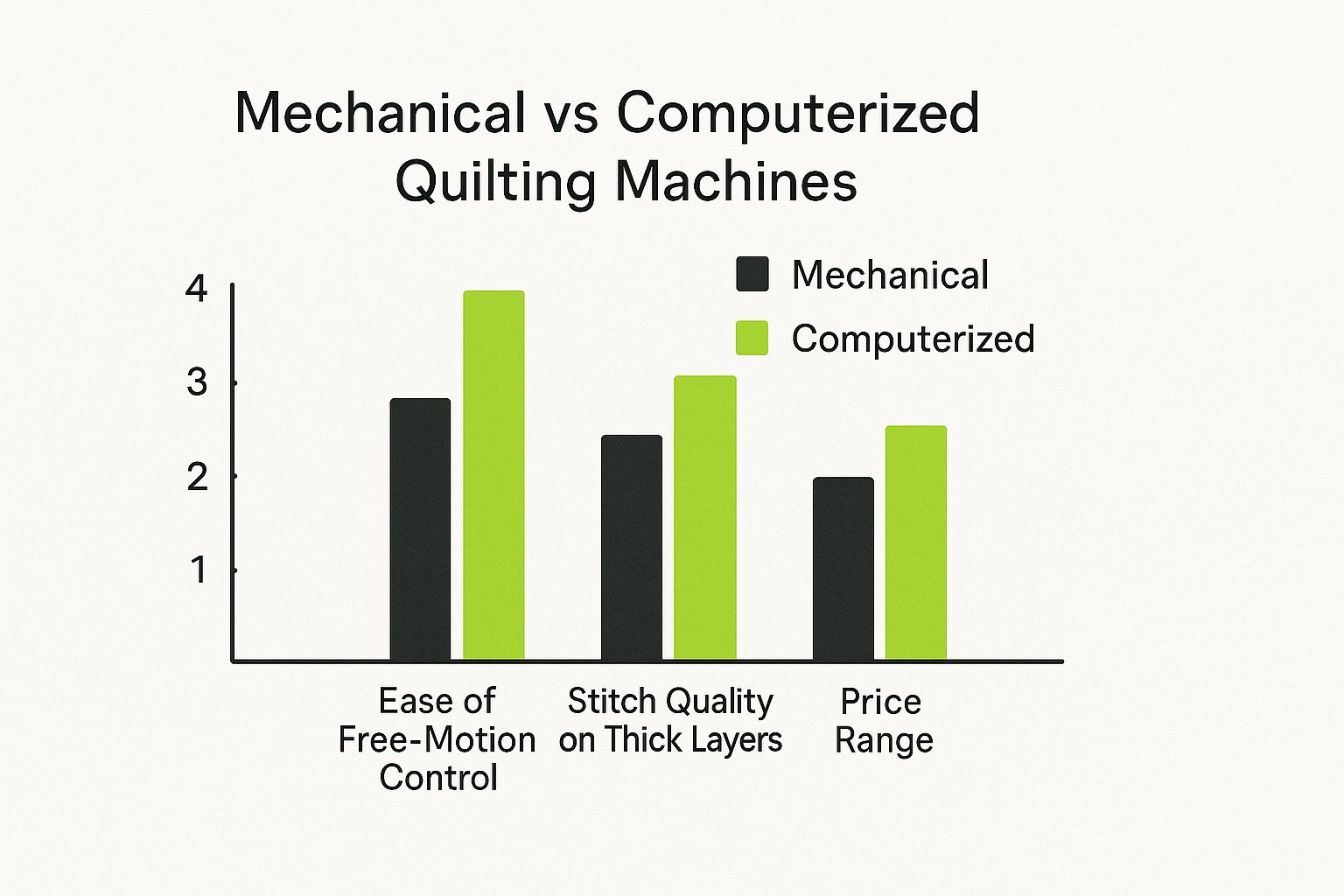
As you can see, computerized machines give you an edge in control for detailed work like free-motion, but a well-built machine of either type can give you beautiful stitch quality, even through thick layers.
Stitch Quality and Overall Value
No matter which way you go, the best sewing machine for beginning quilters is one that lays down a perfect stitch, even when you're sewing through a thick "quilt sandwich" of top, batting, and backing. Both mechanical and computerized machines from good brands can deliver the goods. It all comes down to a strong motor and a well-designed feeding system.
When you think about value, try to picture where you'll be a year from now. A basic mechanical machine might have a lower price tag, which is definitely appealing when you're just dipping your toes in. But if you get hooked and want to tackle more advanced techniques, you might find yourself outgrowing it pretty fast.
A computerized machine, while a bigger investment upfront, often gives you better long-term value. Those convenience features and wider capabilities mean the machine grows with you, from your very first nine-patch block to intricate free-motion designs.
Ultimately, the choice comes down to your learning style and what you dream of creating. At bsewinn.com, we’ve custom-designed our machine lineup to include both tough-as-nails mechanical options and intuitive computerized models. Our extensive online classes and training resources are there to help you master whichever machine you choose, so you can feel confident bringing your quilting ideas to life from day one.
Putting Your New Machine to Work
Okay, let's be honest. Unboxing a new machine is exciting, but the real magic happens when you turn a pile of pretty fabric into your first quilt block. This is where you get to see how all those features we've talked about actually work in real life. It's time to build some confidence, one stitch at a time.
This guide will walk you through making a tangible, simple quilt block. We designed this how-to project specifically for beginners to show you how a quality machine makes getting those sharp, precise points so much easier. You'll get a real feel for the essential tools and settings right away.
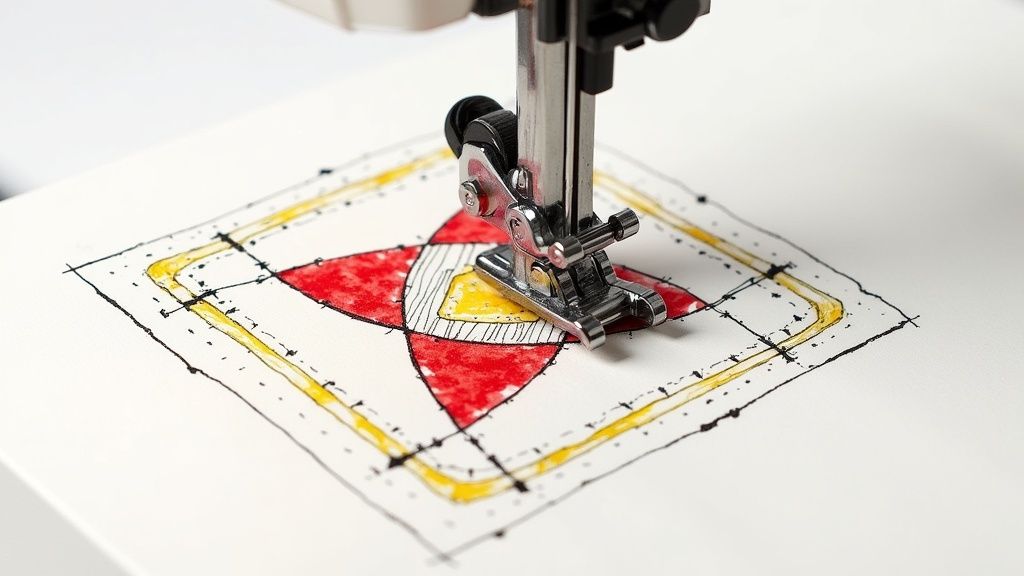
Think of this as building a partnership with your machine. At bsewinn.com, we focus on making this early learning curve feel empowering, not scary, by providing the support you need to replicate beautiful designs.
Your First Quilt Block: A Step-By-Step Guide
For this first project, we're making a simple four-patch block. It’s a cornerstone of quilting and the perfect how-to example for mastering that crucial quarter-inch seam.
- Prep Your Fabric: Start with two different fabric squares, each cut to 5x5 inches. Cutting accurately now is the secret to getting perfect corners later.
- Attach the Walking Foot: Don't skip this! A walking foot is your best friend for accurate piecing. It pulls both layers of fabric through the machine at the exact same speed, which is key to preventing any annoying stretching or shifting.
- Set Your Stitch Length: A shorter stitch length, somewhere around 2.0 to 2.5 mm, is what you want for piecing. It creates a nice, strong seam that won't pull apart when you're pressing and handling the block.
- Sew Your First Seam: Place your two squares with the right sides together. Guide them under the walking foot, using the edge of the foot as your guide for a perfect quarter-inch seam. Remember, let the machine do the work—no pushing or pulling!
Once you've sewn that seam, press it open or to one side. That simple act of joining two squares is the foundation of almost every quilt you'll ever make. Nailing this is a huge first step.
Your first project isn't about perfection; it's about understanding. It's about feeling how the machine handles the fabric and seeing for yourself how a simple tool like a walking foot makes a huge difference in your results. Every single block you make builds that crucial muscle memory.
From First Stitches to Finished Projects
As you sew more blocks, you'll start to see how a good, reliable machine helps you get consistent, accurate pieces that fit together like a dream. This is exactly where the best sewing machine for beginning quilters proves its value—by giving you great results that make you want to keep quilting.
We've found that combining a great machine with clear, accessible education is the secret to unlocking your creativity right from the start. That's why we're so proud of the bsewinn.com online class portal, a key part of the support we offer to empower crafters.

The portal is packed with guided, how-to projects just like this one, offering visual steps that make even tricky techniques feel totally doable. It’s the perfect companion to your hands-on practice, helping you replicate tangible sewing machine designs with confidence.
How Technology Makes Quilting More Accessible
Quilting might be a craft with deep traditional roots, but you don't need my grandmother's old machine to do it. Modern technology has completely opened up the world of quilting, making it far more approachable than ever before.
The latest advancements aren't just about adding flashy buttons; they're about knocking down the frustrating roadblocks that used to make new quilters want to quit. These thoughtful innovations really do shorten the learning curve, letting you jump right into the creative parts you're excited about.
Think of these features as a helpful guide built right into your machine, building your confidence with every single stitch. It makes the hunt for the best sewing machine for beginning quilters so much more exciting, because today’s machines are truly designed to help you succeed.
Innovations That Empower Beginners
Let's talk about some of the game-changing features that simplify tasks that used to be a real headache for new quilters.
Imagine never having to squint and struggle to thread a needle again. An automatic needle threader does it for you in seconds. I know it sounds like a small thing, but trust me, it eliminates a huge source of frustration and gets you to the fun part faster.
Another feature I absolutely love for beginners is the speed control slider. It lets you set a maximum sewing speed, so you can go as slow and steady as you want without worrying about having a lead foot on the pedal. This is a lifesaver when you're learning to guide fabric or trying your hand at free-motion quilting. It gives you the control you need to build that muscle memory without the machine running away from you.
The needle up/down function is probably one of the most impactful features for a new quilter. It lets you program the machine to stop with the needle buried in the fabric. This is the secret to getting sharp, precise points when you pivot at a corner—your project stays perfectly in place while you lift the presser foot and turn.
The Broader Impact on Crafting
This push toward user-friendly tech reflects a huge trend in the sewing industry. In fact, the market for automated sewing machines is expected to grow at a rate of 6.89% through 2030, all because people want consistency and machines that are easier to use. This is fantastic news for quilters, as it means more reliable and intuitive machines are becoming available at every price point. You can read up on sewing machine market trends on MordorIntelligence.com if you're curious.
These features aren't just little conveniences; they genuinely help you create a better final product and make the whole process more enjoyable. Understanding the difference between computerized sewing machines vs mechanical ones is a crucial first step, and choosing a machine with these modern aids can make all the difference.
Your Top Quilting Machine Questions, Answered
Jumping into quilting is exciting, but I get it—choosing your first machine can feel like a huge decision. There are so many options, so much advice, and it's easy to get overwhelmed. I’ve been there! Let's clear up some of the most common questions I hear from new quilters, so you can feel confident and ready to start stitching.
My goal here is to cut through the noise and give you some straight answers. Let's tackle those questions you've probably been wondering about.
Do I Really Need a “Quilting” Machine to Start?
Honestly, you can piece a quilt top on just about any standard sewing machine. But a machine with a few key quilting features will make your life so much easier and the whole process way more fun. The best sewing machine for beginning quilters isn't about being fancy; it's about solving the unique problems that come with quilting.
Think of it this way: a bigger "throat space" (the area to the right of the needle) gives you room to maneuver your quilt without a fight. A walking foot helps feed all those bulky layers evenly. And features for free-motion stitching open up a whole new world of creativity. For a beginner, these things aren't just bells and whistles—they’re frustration-savers that help you get a beautiful finish from day one.
What's the Single Most Important Feature for a Beginner?
Hands down, it's consistent stitch quality. Nothing else matters if your machine can't produce a straight, even stitch through a quilt sandwich (top, batting, and backing). That perfect stitch is what holds your masterpiece together. If the stitches are wonky, the whole quilt suffers.
Right after that, the most valuable tool in your arsenal will be a walking foot (sometimes called an even-feed foot). This little add-on is the secret to preventing puckers and shifting fabric. It grabs the top and bottom layers of your quilt and pulls them through at the same speed, which is an absolute game-changer.
It’s a common rookie mistake to get dazzled by a machine with hundreds of decorative stitches. The truth is, 99% of quilting is done with a straight stitch. A machine that masters that one simple stitch is worth far more than one with a hundred fancy options you’ll almost never touch.
Should I Get a Mechanical or a Computerized Machine?
There’s a good case for both. Mechanical machines are workhorses—they're often cheaper, super durable, and you control everything with manual dials. They're fantastic for learning the basics of piecing and just getting comfortable.
However, I usually find that a computerized machine offers better long-term value for a new quilter. Features like push-button stitch selection, a speed control slider (so you don't feel like you're in a drag race), and the must-have needle up/down function really simplify things. These features help build your confidence and will be there for you when you’re ready to try more advanced techniques like free-motion quilting.
How Much Should I Expect to Spend on a Starter Quilting Machine?
You definitely don't need to take out a second mortgage for a great machine. For a reliable, beginner-friendly machine that will handle quilting beautifully, you can expect to spend somewhere in the $250 to $600 range.
Machines in this sweet spot typically have a solid metal frame, all the essential stitches you'll actually use, and often come with that all-important walking foot. Making a smart investment upfront means you get a machine that can grow with you, saving you from the frustration of "outgrowing" a cheaper model in just a few months.
At B-Sew Inn, we are committed to empowering your creativity, right from that very first stitch. We’re here to help you succeed with our custom-designed machines, extensive online classes, training, and a supportive community ready to help you create designs you love.
Explore our collection of beginner-friendly sewing and quilting machines today!

